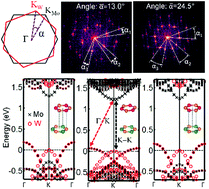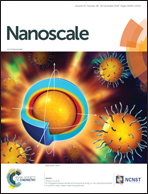Interlayer interactions in 2D WS2/MoS2 heterostructures monolithically grown by in situ physical vapor deposition†
Abstract
The understanding of the interlayer interactions in vertical heterostructures of two-dimensional (2D) transition metal dichalcogenides (TMDCs) is essential to exploit their advanced functions for next-generation optoelectronics and electronics. Here we demonstrate a monolithic stacking of TMDC heterostructures with 2D MoS2 and WS2 layers via in situ physical vapor deposition. We find that the kinetically sputtered atoms are able to overcome the interlayer van der Waals forces between the vertical layers, leading to a substantial number of randomly oriented stacks with various twist angles. Our X-ray photoelectron spectroscopy results reveal a type II heterojunction for 2D WS2/MoS2, showing a band alignment with a conduction band offset of 0.41 eV and a valence band offset of 0.25 eV. In particular, we observed a remarkable interlayer coupling and associated exciton relaxation at the hetero-interface due to the misoriented stacks. By analyzing the band structures and charge densities of the vertical stacks using first-principles calculations, we reveal that the interlayer coupling is a function of the interlayer distance and is relatively insensitive to the angle of misorientation.



 Please wait while we load your content...
Please wait while we load your content...